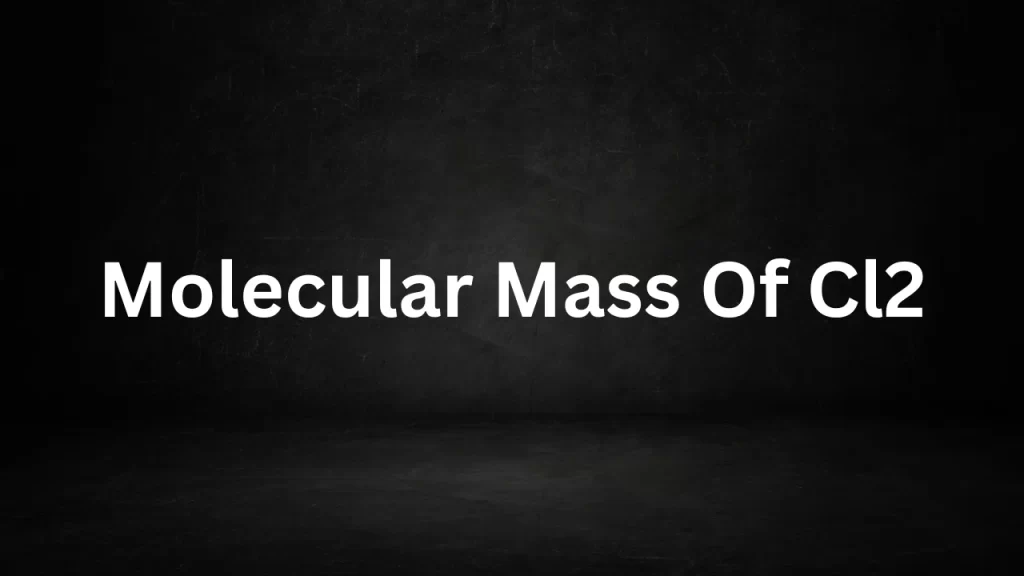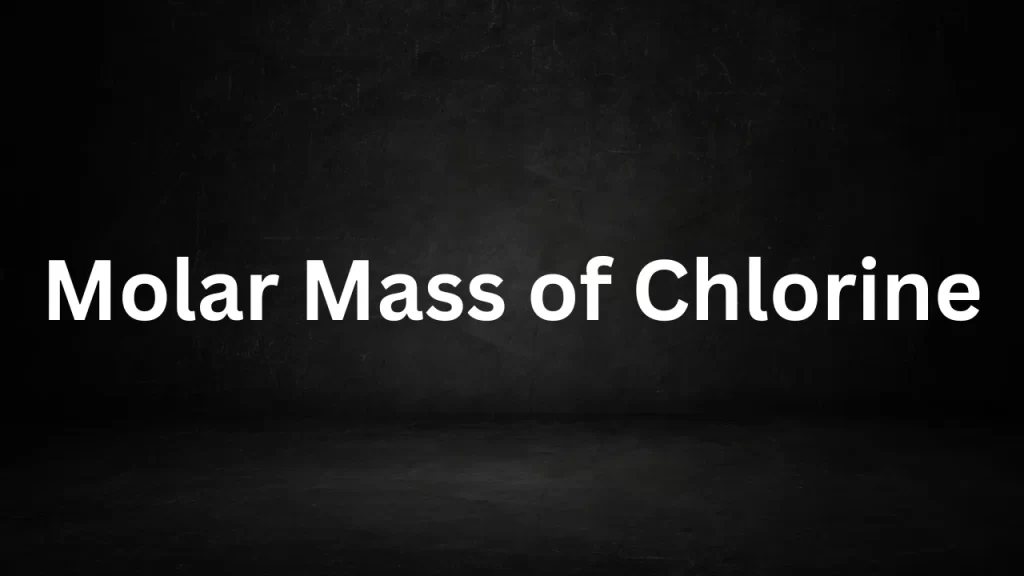Tag: chlorine molar mass
Molecular Mass Of Cl2
Molecular Mass Of Cl2: Chlorine gas, represented as Cl2, is a diatomic molecule composed of two chlorine (Cl) atoms covalently bonded together.
Understanding the mole mass of Cl2 is fundamental in various scientific, industrial, and environmental applications. In this article, we will explore the mole mass of Cl2, its composition, and its relevance in different fields.

Molecular Mass Of Cl2
The Composition of Chlorine Gas
Chlorine gas (Cl2) consists of two chlorine (Cl) atoms bonded together. Chlorine gas is a gas that appears pale greenish-yellow and has a distinctive, pungent odor. It is widely employed across various industries, including water treatment, disinfection, and chemical synthesis, among others.
Calculating the Molecular Mass
To calculate the mole mass of Cl2, we need to consider the atomic masses of chlorine (Cl). The atomic mass of chlorine (Cl) is approximately 35.453 atomic mass units (amu).
The molar mass, also known as molar weight, of Cl2 is determined by summing the atomic masses of its constituent elements.
Molecular Mass of Cl2 = 2 × Atomic Mass of Cl Molecular Mass of Cl2 = 2 × 35.453 amu Molecular Mass of Cl2 ≈ 70.906 amu
Therefore, the molar mass of chlorine gas (Cl2) is approximately 70.906 atomic mass units (amu) or 70.906 grams per mole (g/mol).
Significance of Cl2’s Molecular Mass
- Water Treatment: Chlorine gas is commonly used to disinfect water in municipal water treatment facilities. Its molecular mass is essential in calculating the required dosage for effective disinfection.
- Chemical Synthesis: Chlorine gas finds application in manufacturing various chemicals, including PVC (polyvinyl chloride), pesticides, and solvents production. Its molecular mass is crucial in reaction stoichiometry.
- Environmental Monitoring: Monitoring chlorine gas emissions in industrial processes and understanding its molecular mass are essential for assessing and controlling environmental impact.
- Healthcare: Chlorine gas exposure can be harmful to human health. The assessment of health risks related to exposure and the development of safety measures take into account its molecular mass.
- Material Compatibility: Understanding the mole mass of Cl2 is important in materials science to assess the compatibility and resistance of materials used in chlorine-handling equipment.
Conclusion
Chlorine gas, with its mole mass of approximately 70.906 atomic mass units (amu), is a versatile chemical compound with a wide range of applications in water treatment, chemical synthesis, and various industries. Although it serves as a valuable tool for disinfection and chemical processes, it also presents challenges concerning safety and environmental impact.. As we continue to rely on chlorine gas for various purposes, understanding its molecular mass remains a fundamental aspect of its safe and effective use in scientific, industrial, and environmental contexts.
Read More
- Molecular Weight Of K
- Molecular Mass Of Iron
- Molecular Weight Of NH3
- Molecular Mass Of Methane
- Molecular Mass Of N2
Frequently Asked Questions (FAQs) On Molecular Mass Of Cl2
1. What is Cl2, and why is its molecular mass important?
Cl2 is chlorine gas, composed of two chlorine (Cl) atoms. Its mole mass is crucial in various scientific, industrial, and environmental applications.
2. How does the molecular mass of Cl2 relate to environmental monitoring?
Understanding the molecular mass of Cl2 is crucial for monitoring emissions in industrial processes and assessing its environmental impact.
3. What are the health implications of chlorine gas exposure, and how does its molecular mass factor in?
Exposure to chlorine gas poses health risks, and its molar mass is a vital factor to consider when assessing these hazards and implementing safety measures.
4. Why is the molecular mass of Cl2 important in materials science?
In materials science, the molar mass of Cl2 is employed to assess the compatibility and longevity of materials employed in equipment intended for chlorine handling.
5. Are there particular analytical techniques that utilize the molar mass of Cl2?
Indeed, the molar mass of Cl2 plays a role in various analytical methods, including mass spectrometry, which aids in identifying and quantifying chlorine-containing compounds within samples.
Molar Mass of Chlorine
Molar Mass of Chlorine: The molar mass of an element is a fundamental concept in chemistry, crucial for various calculations in the field. In this article, we will delve into the molar mass of chlorine (Cl), one of the essential elements on the periodic table.

Molar Mass of Chlorine
Introduction to Chlorine
Chlorine is a chemical element with the symbol Cl and atomic number 17. It is a halogen, belonging to Group 17 (formerly Group VIIA) of the periodic table. Chlorine is a diatomic molecule in its natural form, existing as Cl2 gas. It is known for its distinctive pungent odor and is commonly used in a variety of industrial and household applications, such as water disinfection, bleach production, and as a component in various chemicals.
Atomic Structure of Chlorine
To understand the molar mass of chlorine, we must first examine its atomic structure. A chlorine atom consists of 17 electrons, arranged in three energy levels or electron shells. The electron configuration of chlorine is 2-8-7, indicating that it has two electrons in the first shell, eight electrons in the second shell, and seven electrons in the third shell. The outermost shell, with its seven electrons, is referred to as the valence shell.
Chlorine’s atomic number, 17, tells us it has 17 protons in its nucleus, giving it a positive charge. It also has 17 electrons to balance this charge, making it electrically neutral. In addition to the protons and electrons, the nucleus of a chlorine atom contains 18 neutrons, which are electrically neutral particles with a mass similar to that of protons.
Molar Mass of Chlorine
The molar mass of an element is defined as the mass of one mole of atoms of that element, measured in grams per mole (g/mol). It is a crucial quantity for chemical calculations because it allows chemists to relate the mass of a substance to the number of atoms or molecules it contains. To calculate the molar mass of chlorine, we need to consider the contributions of its isotopes.
Chlorine has two stable isotopes: chlorine-35 (17 protons and 18 neutrons) and chlorine-37 (17 protons and 20 neutrons). These isotopes occur in nature in different proportions. Approximately 75.77% of naturally occurring chlorine is chlorine-35, while the remaining 24.23% is chlorine-37.
To calculate the molar mass of chlorine, we take a weighted average of the masses of these isotopes, using their natural abundance as the weighting factor:
Molar Mass of Chlorine (Cl) = (Fractional Abundance of Cl-35 × Mass of Cl-35) + (Fractional Abundance of Cl-37 × Mass of Cl-37)
Molar Mass of Chlorine (Cl) = (0.7577 × 35.453 g/mol) + (0.2423 × 37.967 g/mol)
Molar Mass of Chlorine (Cl) ≈ 26.94 g/mol
So, the molar mass of chlorine is approximately 26.94 grams per mole.
Importance of Molar Mass
The molar mass of chlorine is a fundamental value used in various chemical calculations. It is essential in determining the amount of chlorine needed for specific reactions, stoichiometry calculations, and the formulation of chemical equations. Additionally, molar mass plays a critical role in determining the concentration of chlorine in solutions and mixtures, such as in water treatment processes.
Understanding the molar mass of elements is a fundamental step in mastering chemistry, as it forms the basis for various chemical calculations and laboratory experiments. Chlorine, with its molar mass of approximately 26.94 g/mol, is no exception, and its properties and behavior in chemical reactions are deeply influenced by this important value.
Read More
- Electrical Energy And Power
- Dynamics Of Circular Motion
- Molecular Weight Of Acetic Acid
- Difference Between Torque And Power
- Difference Between Emission And Absorption Spectra
Frequently Asked Questions (FAQs) Molar Mass of Chlorine
Q1: What is the mol mass of chlorine?
A1: The mol mass of chlorine (Cl) is approximately 26.94 grams per mole (g/mol).
Q2: Why is the mol mass of chlorine important in chemistry?
A2: The mol mass of chlorine is crucial in chemistry because it allows chemists to relate the mass of chlorine atoms or molecules to the number of atoms or molecules present. It plays a fundamental role in stoichiometry, chemical calculations, and the formulation of chemical equations.
Q3: How is the mol mass of chlorine calculated?
A3: The mol mass of chlorine is calculated by taking a weighted average of the masses of its isotopes, chlorine-35 and chlorine-37, using their natural abundances as weighting factors. Approximately 75.77% of naturally occurring chlorine is chlorine-35, and about 24.23% is chlorine-37. The calculation is as follows:
mol Mass of Chlorine (Cl) = (Fractional Abundance of Cl-35 × Mass of Cl-35) + (Fractional Abundance of Cl-37 × Mass of Cl-37)
Q4: What is the significance of chlorine’s atomic number and electron configuration?
A4: Chlorine’s atomic number, 17, indicates the number of protons in its nucleus, which defines its chemical identity. Its electron configuration, 2-8-7, reveals the arrangement of its electrons in energy levels or electron shells, helping us understand its chemical behavior and reactivity.
Q5: Are there any practical applications of chlorine’s mol mass?
A5: Yes, there are practical applications of chlorine’s molar mass. It is used in various industries and applications, including water treatment, where the concentration of chlorine in solutions must be precisely controlled for effective disinfection. Additionally, the mol mass of chlorine is used in chemical manufacturing processes and in calculating the quantities of chlorine needed for specific reactions.